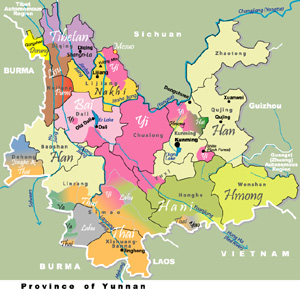|
Other names of Yunnan:
Dian (short form), Yun (short form)
Adjective: Yunnanese (uncommon)
History
Yunnan's mountainous terrain makes it the Switzerland of Asia. Its
cultural and religious diversity is reflected in the people's clothes,
songs, dances and festivals. Twenty six nationalities are
recognized by the Government of China. Many of them are
descendants of the nomadic Qiang People on the Tibetan Plateau.
Yunnan's Han Chinese culture is quite different from that of other
provinces as well, most notably in their cuisine. Despite this diversity, Yunnan has
had a relatively peaceful history. Two kingdoms dominated the area
during much of Yunnan's history, the Nakhi and the Nanzhao, which later
became the Kingdom of Dali. The Nakhi became a protectorate
of China in 794 AD (during the Tang Dynasty). Like much of western
China, kingdoms were crushed during invasion by the Mongols in the late
1200's and later by the Manchus. The entire Province of Yunnan fell into the hands of the
Manchus in 1723, soon after the rest of China was
invaded. The newly formed Manchu Chinese Empire (Qing Dynasty)
lasted for more than 200 years.
Geography
Yunnan is probably the most culturally
and ecological diverse province of China. From the subtropical
forests of the south to the foothills to the world's highest Tibetan
Plateau in
the north, Yunnan's diverse ecosystems is home to the more species of
rhododendrons than anywhere else in the world. From this beautiful
province radiates five of Asia's most important rivers: the Yangtse
flowing towards Shanghai, the Mekong towards Ho Chi Minh City, the
Salween towards Rangoon, Burma, the Hong Ha towards Hanoi, Vietnam, and
the Nanpan Jiang which eventually makes its way to Macau.
Culture
Many of the nations of Yunnan speak Tibeto-Burmese or Tong-Thai
languages. The Han speak Kunming dialect of Chinese.
Southern Yunnan is home to the Dai, a close relatives
of the people of Thailand, the Hmong (Miao or Meo). The
western and northern mountain ranges and valleys are inhabited by Tibetans, and
Nakhi (Naxi), the Bai, and many
other nations. The Old City of Lijiang displays the cultural mosaic of
Northern Yunnan. In the past, women have higher status in many of
Yunnan's nations compared to the rest of China. The Mosuo People
(inhabitants of the Lugu Lake Area; close relatives of the Nakhi)
display many aspects of a
matriarchical society. The City of Kunming (mostly Han) has been
influenced by the other nationalities.
Yunnan Today
Kunming was the site of Expo 1999. Its theme, unlike any other
technologically-driven expos, was gardening. The city of Lijiang
and the high parallel mountain chains of western Yunnan have been
declared UNESCO world heritage sites. Yunnan has become some the
most popular places by domestic Chinese travelers as well as foreign
tourists. It is no longer possible to find the serenity that
Yunnan once possessed. However, the cool climate and
pedestrian-oriented cities provide a good retreat from the hustle and
bustle of the rest of East Asia. Problems and
Challenges
Its proximity to the opium trade that once dominated the North of
Thailand has given Yunnan a bad name. Numerous dams have been proposed by the government along the Nu Jiang,
Lancang Jiang (Mekong), and the Yangtse. Some local farmers are
worried that the dams would flood the few cultivable valleys in the
region. The rise of tourism also brings problems such as pollution
and noise to the region. In recent years, tourism and over
commercialization has brought problems such as pollution and traffic
congestions. Tourism in Yunnan, having started later
than coastal provinces, has shown to be less destructive than the
"pioneer provinces". Traditional architecture in cities
such as Lijiang and Dali are kept intact; pollution is dealt with more
vigourously.
|

 Photo Essay of Yunnan
Photo Essay of Yunnan